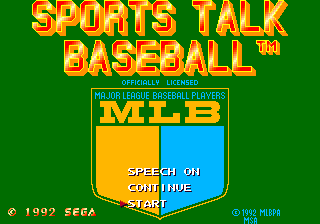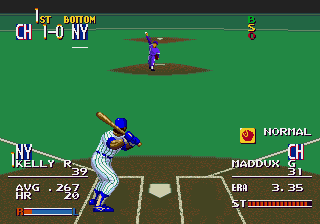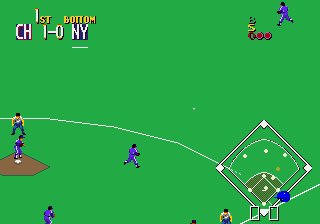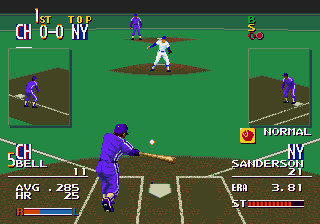Sports Talk Baseball is a 1992 baseball game by Sega for the Sega Mega Drive released exclusively in the US. It takes Pro Yakyuu Super League '91 and replaces the music with a running commentary in the style of Joe Montana II Sports Talk Football (done by various Western Technologies employees).
Sports Talk Baseball is licensed by the Major League Baseball Players Association, so it includes real players. It does not, however, have a full Major League Baseball license, so teams are referred to solely by their cities or states.
Gameplay
The game follows the rules of MLB baseball. Unlike real professional baseball, there is a "mercy" rule that ends the game when one team is leading by 10 or more runs. There are three modes:
- Pennant Race: A single-player mode where the player plays a season of 15, 30, 81, or a full 162 games.
- Exhibition Game: A single match against the computer or a five-game series against another player. Up to five players can participate in a round robin tournament format.
- All Pro Game: A single match against the computer or another player, pitting the American League All Pro Team against the National League All Pro Team (similar to the Major League Baseball All-Star Game). Players can substitute players from any team in either league to create a custom team.
Players can choose from any of the 26 teams, with rosters accurate for the 1991 season. Before each game, each team can choose a starting pitcher, order the batting line-up, change each player's position, and substitute players. Players can choose from three venues: the White Sky Dome (standard-sized field in a dome), the Blue Moon Stadium (largest field, nighttime game), or the Red Sun Stadium (smallest field, daytime game). In single-player games, the player can additionally choose whether to bat or field first, to disable auto-fielding (where the computer automatically positions outfielders), and to make changes to the computer player's roster.
|
|
Defense
|
When pitching,  and and  position the pitcher on the mound and position the pitcher on the mound and  throws the ball. While throwing, use throws the ball. While throwing, use  and and  for a breaking ball, for a breaking ball,  to throw a change-up (slow pitch), or to throw a change-up (slow pitch), or  to throw a fastball. Faster pitches are harder for the batter to hit but more likely to travel farther or potentially result in a home run. The batter is eliminated when three strikes are thrown; the batter gets a free base if the pitcher throws four balls or a "beanball" (hitting the batter with the pitch). to throw a fastball. Faster pitches are harder for the batter to hit but more likely to travel farther or potentially result in a home run. The batter is eliminated when three strikes are thrown; the batter gets a free base if the pitcher throws four balls or a "beanball" (hitting the batter with the pitch).
Pitchers have a stamina gauge. Fastballs and curve balls wear out pitchers faster. When a pitcher is low on stamina, the ball becomes harder to control. The player can substitute a relief pitcher by pausing the game with START and pressing  . Pitchers have their strengths summarized by a graph showing change-ups and fastballs on the y-axis and breaking balls on the x-axis. . Pitchers have their strengths summarized by a graph showing change-ups and fastballs on the y-axis and breaking balls on the x-axis.
While pitching, the player can change the position of the fielders with  : Forward is more effective at catching ground balls and bunts, Back is more effective at catching fly balls from hard hitters, and Normal is the most flexible balance between the two. The player can also switch to a fielding view with : Forward is more effective at catching ground balls and bunts, Back is more effective at catching fly balls from hard hitters, and Normal is the most flexible balance between the two. The player can also switch to a fielding view with  , which can be used to catch players trying to steal bases. , which can be used to catch players trying to steal bases.
When fielding, the D-Pad controls the fielder closest to the ball. The player can have the nearest fielder jump by pressing  or dive by pressing or dive by pressing  while holding a direction. Once the ball is in possession, it can be thrown to base by pressing while holding a direction. Once the ball is in possession, it can be thrown to base by pressing  while holding a direction corresponding to the base ( while holding a direction corresponding to the base ( for first, for first,  for second, for second,  for third, or for third, or  for home) or press for home) or press  by itself to throw to first base. by itself to throw to first base.
|
|
|
Offense
|
When hitting, the D-Pad positions the batter in the batter's box. The batter swings with  or bunts with or bunts with  . The player can lead-off or attempt to steal a base by pressing . The player can lead-off or attempt to steal a base by pressing  while holding a direction corresponding to a base ( while holding a direction corresponding to a base ( for first, for first,  for second, for second,  for third, or for third, or  for home). Runners can slide into base by pressing for home). Runners can slide into base by pressing  while holding a direction corresponding to the base. while holding a direction corresponding to the base.
The player can substitute a pinch hitter by pausing the game with START and pressing  . Players have their strengths summarized by a graph with throwing (north), fielding (south), power (west), and speed (east). . Players have their strengths summarized by a graph with throwing (north), fielding (south), power (west), and speed (east).
|
Teams
| League |
Division |
Team |
Based on
|
| American
|
Western
|
California |
California Angels
|
| Kansas City |
Kansas City Royals
|
| Chicago |
Chicago White Sox
|
| Seattle |
Seattle Mariners
|
| Oakland |
Oakland Athletics
|
| Texas |
Texas Rangers
|
| Minnesota |
Minnesota Twins
|
| Eastern
|
Baltimore |
Baltimore Orioles
|
| Cleveland |
Cleveland Indians
|
| Boston |
Boston Red Sox
|
| New York |
New York Yankees
|
| Milwaukee |
Milwaukee Brewers
|
| Toronto |
Toronto Blue Jays
|
| Detroit |
Detroit Tigers
|
| National
|
Western
|
Atlanta |
Atlanta Braves
|
| San Diego |
San Diego Padres
|
| Los Angeles |
Los Angeles Dodgers
|
| Houston |
Houston Astros
|
| Cincinnati |
Cincinnati Reds
|
| San Francisco |
San Francisco Giants
|
| Eastern
|
Chicago |
Chicago Cubs
|
| Pittsburgh |
Philadelphia Phillies
|
| Philadelphia |
Detroit Tigers
|
| New York |
New York Mets
|
| Montreal |
Montreal Expos
|
| St. Louis |
St. Louis Cardinals
|
Production credits
- Main Programmer: Mizoran
- Assistant Programmer: 武
- Graphic Designer: Sadachan, Vaon, 7LY Big King, Thomas ♥ Yuuda, Rice
- Game Designer: Vanta
- Voice and Sound by: Vestern Technologies
- Allen Maynard
- Jeff Fort
- Ray Frericks
- E.S.S.
- Translations by: Takeshi Sumida, James Gros
- Special Thanks: Ohsan, The Fort, Silver Chariots, Mudamudamudamudamuda, Kongotomo Yoroshiku, Sushi-X Modoki, Dio Sama, Team Clutch Hitter, Pochi
- © 1992 MLBPA
- © 1992 SEGA
Magazine articles
- Main article: Sports Talk Baseball/Magazine articles.
Promotional material
Print advert in
GamePro (US) #34: "May 1992" (1992-xx-xx)
Physical scans
| {{{{{icon}}}|L}}
|
Division by zero.
|
Based on
0 review
|
| Mega Drive, US
|
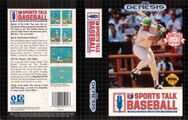 Cover
|
|
|
Technical information
- Main article: Sports Talk Baseball/Technical information.
ROM dump status
| System |
Hash |
Size |
Build Date |
Source |
Comments |
|
|
|
| ✔
|
| CRC32
|
0deb79c2
|
| MD5
|
dda511735e821d69c58ab19c4c9e5465
|
| SHA-1
|
e223513d9bcecb49a6798720f3195dbd1c34681c
|
|
1MB
|
1992-02
|
Cartridge (US)
|
|
|
|
|
References
- ↑ Sega Visions, "May/June 1992" (US; 1992-xx-xx), page 58
- ↑ 2.0 2.1 GamePro, "June 1992" (US; 1992-xx-xx), page 46
- ↑ 1700 igr dlya Sega, "" (RU; 2001-xx-xx), page 287
- ↑ Game Power, "Luigio/Agosto 1992" (IT; 1992-0x-xx), page 56
- ↑ Mega, "October 1992" (UK; 1992-09-17), page 54
- ↑ Mega Action, "June 1993" (UK; 1993-05-20), page 64
- ↑ Sega Pro, "October 1992" (UK; 1992-09-10), page 38
- ↑ Sega Pro, "April 1993" (UK; 1993-03-11), page 67
- ↑ Supergame, "Outubro 1992" (BR; 1992-10-xx), page 24
- ↑ Tricks 16 bit, "Tricks Sega Gold 800 igr" (RU; 1998-03-20), page 171
- ↑ Zero, "August 1992" (UK; 1992-07-xx), page 27
